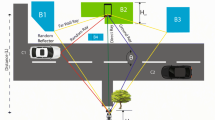Abstract
The next generation of cellular network deployment is heterogeneous and temporally changing in order to follow the coverage and capacity needs. Active Antenna Systems allows fast deployment changes by cell shaping and tilt adaptation which have to be controlled in self-organized manner. However, such kind of automated and flexible network operations require a Self Organizing Network (SON) algorithm that works based on network performance parameters being partly derived from the radio measurements. Thus, appropriate radio propagation models are not only needed for network planning tools but also for simulative lab tests of the developed SON algorithm controlling the flexible deployment changes enabled by Active Antenna Systems. In this paper, an extension of the existing 3D propagation model is proposed in order to incorporate the propagation condition variation effects, not considered so far, by changing antenna beam orientation like antenna tilting or when users are distributed in the third dimension (height) in multi-floor scenarios. Ray tracing based generated propagation maps that show the realistic propagation effect are used as 3D real world reference for investigation and model approval.














Similar content being viewed by others
References
Walfisch, J., & Bertoni, H. L. (1988). A theoretical model of UHF propagation in urban environments. IEEE Transactions on Antennas and Propagation, 36(12), 1788–1796.
Ikegami, F., Yoshida, S., Umehira, M., & Takeuchi, T. (2003). Propagation factors controlling mean field strength on urban streets. IEEE Transactions on Antennas and Propagation, 36(8), 317–325.
Hata, M. (1980). Empirical formula for propagation loss in land mobile radio services. IEEE Transactions on Vehicular Technology, 29(3), 822–829.
Cichon, D. J., & Kürner, T. (1999). Propagation prediction models. COST Telecommunications Action 231 Final Report, COST Telecom Secretariat, Commission of the European Communities, Brussels, Belgium, pp. 117–195.
Stüber, G. (2011). Principles of mobile communication (3rd ed.). Springer New York Dordrecht Heidelberg London: Springer.
3GPP. (2006). Evolved universal terrestrial radio access (E-UTRA); Further advancements for (E-UTRA) Physical layer aspect, 3rd Edition. TR 36.814, 19–21.
Yilmaz, O., Hämäläinen, S., & Hämäläinen, J. (2009). System level analysis of vertical sectorization for 3GPP LTE: 6th International Symposium on Wireless Communication Systems. ISWCS, 2009, 453–457.
Kifle, D. W., Wegmann, B., Viering, I., & Klein, A. (2013). Impact of antenna tilting on propagation shadowing model. IEEE 77th Vehicular Technology Conference (VTC Spring).
Okamoto, H., Kitao, K., & Ichitsubo, S. (2009). Outdoor-to-indoor propagation loss prediction in 800-MHz to 8-GHz band for an urban area. IEEE Transactions on Vehicular Technology, 58(3), 1059–1067.
Berg, J. E. (1999). Propagation Prediction Models (building penetration). COST Telecommunications Action 231 Final Report, COST Telecom Secretariat, Commission of the European Communities, Brussels, Belgium, pp. 167–174.
Wölfle, G., Wahl, R., Wildbolz, P., & Wertz, P. Dominant path prediction model for indoor and urban scenarios. AWE Communications, Tech. Rep.
Burger, S. (2003). Accuracy of winprop 3D intelligent ray tracing: AWE Communications. Tech. Rep.
Rappaport, T. S., & Sandhu, S. (1994). Radio-wave propagation for emerging wireless personal-communication systems. IEEE Antennas and Propagation Magazine, 36(5), 14–24.
Giland, F., Claro, A., Ferreira, J., Pardelinha, C., & Correia, L. (2001). A 3D interpolation method for base-station-antenna radiation patterns. IEEE Antennas and Propagation Magazine, 43(2), 132–137.
Huemer, E., & Lensing, K. (2000). Practical antenna guide. KATHREIN MOBILCOM BRASIL Ltda, Tech. Rep.
Author information
Authors and Affiliations
Corresponding author
Rights and permissions
About this article
Cite this article
Kifle, D.W., Gimenez, L.C., Wegmann, B. et al. Comparison and Extension of Existing 3D Propagation Models with Real-World Effects Based on Ray-Tracing. Wireless Pers Commun 78, 1719–1738 (2014). https://doi.org/10.1007/s11277-014-1910-0
Published:
Issue Date:
DOI: https://doi.org/10.1007/s11277-014-1910-0




